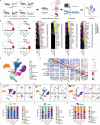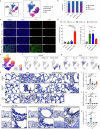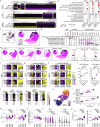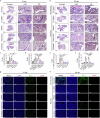Prolonged immune activation in post-acute sequelae of SARS-CoV-2: neutrophil dynamics and therapeutic insights
- PMID: 40987794
- PMCID: PMC12508235
- DOI: 10.1038/s12276-025-01539-5
Prolonged immune activation in post-acute sequelae of SARS-CoV-2: neutrophil dynamics and therapeutic insights
Abstract
Post-acute sequelae of SARS-CoV-2 (PASC) is characterized by persistent symptoms such as fatigue, respiratory complications and cognitive dysfunction, affecting approximately 13.5% of SARS-CoV-2-infected individuals. Despite its clinical significance, the mechanisms driving PASC remain poorly understood. Here, to address this, we utilized a Phodopus roborovskii hamster model to investigate the long-term effects of SARS-CoV-2 infection compared with influenza A virus. While 46.25-47.50% of hamsters survived SARS-CoV-2 or influenza A virus H1N1 infection, 13.75% of SARS-CoV-2 survivors exhibited impaired weight recovery, severe lung pathology and significant neutrophil accumulation, defining the PASC group. Single-cell RNA sequencing of bronchoalveolar lavage fluid, lung and spleen at 30 days post-infection revealed hallmark PASC gene signatures uniquely upregulated in the PASC group. This was accompanied by elevated neutrophil levels and reduced macrophage populations, indicative of disrupted myeloid cell differentiation. Immunohistochemistry further detected persistent SARS-CoV-2 S1 subunit antigen in the lungs of PASC hamsters at 30 days post-infection, coinciding with marked neutrophil infiltration, which probably drove prolonged inflammatory responses. Indeed, the neutrophils in the PASC group exhibited sustained upregulation of inflammation-related genes, including FPR2, MMP9 and S100A9, which are associated with neutrophil degranulation and extracellular trap formation. Importantly, targeting neutrophil-mediated inflammation with small-molecule inhibitors substantially reduced PASC phenotypes. Among these, Sivelestat, a neutrophil elastase inhibitor, demonstrated the most pronounced efficacy, reducing PASC incidence and mortality, and markedly reducing neutrophil levels. These findings underscore the critical role of neutrophil activation in driving lung damage and chronic inflammation during PASC, offering promising therapeutic strategies for mitigating long-term COVID-19 sequelae.
© 2025. The Author(s).
Conflict of interest statement
Competing interests: The authors declare no competing interests.
Figures








References
-
- Manirambona, E., Okesanya, O. J., Olaleke, N. O., Oso, T. A. & Lucero-Prisno, D. E. III Evolution and implications of SARS-CoV-2 variants in the post-pandemic era. Discov. Public Health21, 16 (2024).
MeSH terms
Substances
Grants and funding
LinkOut - more resources
Full Text Sources
Medical
Miscellaneous

